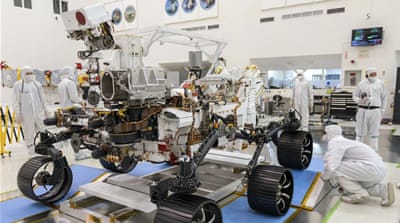NASA’s Perseverance rover lifts off to Mars
Rover will search for evidence of life and help bring NASA one step closer to landing humans on Mars.

NASA is heading back to Mars, and this time, the agency’s objective will be to search for signs of ancient life. To that end, NASA is launching a car-sized rover named Perseverance that could help answer some fundamental questions about life in the universe.
The agency has been exploring the Red Planet for decades, but one big question in particular still remains: Was there ever life on Mars?
Keep reading
list of 4 itemsPhotos: Mexico, US, Canada mesmerised by rare total solar eclipse
Moment total solar eclipse occurs in North America
Millions across North America await total solar eclipse
The story of life beyond Earth is one that has driven Martian exploration plans over the decades. And NASA is on the cusp of launching its most advanced robotic explorer yet.
The Perseverance Mars rover blasted off on July 30, kick-starting a 6.5-month journey that culminates in one intense landing on the Red Planet.
Upon its arrival, the intrepid explorer will join a small fleet of landers and orbiters whose past discoveries have brought us to this moment.

A cosmic detective
NASA’s approach to understanding Mars has been incremental. The initial plan was to follow the water. Thanks to incredible maps captured by multiple spacecraft orbiting the Red Planet, we know that Mars only appears to be a dry, desert world. However, Mars contains pockets of water and water ice.
All of the previous NASA rovers – Curiosity, Spirit and Opportunity – have not only made incredible discoveries, but were able to build a case indicating that Mars was once a habitable world.
Alas, “habitable” does not necessarily mean the planet had inhabitants. And that’s where Perseverance comes into play.
The six-wheeled rover is charged with investigating a region known as Jezero Crater. The 45km (28-mile-long) crater is the site of an ancient lake bed that’s more than three billion years old.
Hailed as one of the most habitable places on Mars, Jezero offers the ability to examine an ancient river delta where flowing waters came together and left behind a treasure trove of sediments that could potentially contain signs of life called biosignatures.
Acting as a cosmic detective, the rover will roam around the crater, collecting clues that will help scientists answer a question that has puzzled humanity for centuries: Are we alone?
“We don’t know yet if life existed on Mars, but we do know that Mars, at one point in its history, was habitable,” NASA Administrator Jim Bridenstine told Al Jazeera.
Now the rover is equipped with a sophisticated suite of scientific instruments that can conduct in situ science on Mars. The rover won’t be digging for fossils as we know them here on Earth, but will be hunting for evidence of organic compounds and minerals within the rocks that could be indicative of single-celled organisms.
In order to interpret those signs, scientists will help Perseverance collect samples for eventual return to Earth.
“One of the main goals of the mission is actually to collect samples to bring back to Earth,” Lori Glaze, director of NASA’s Planetary Science Division, told Al Jazeera. “That’s because some of the signs of life, we aren’t able to detect in situ, we’re going to really require them to come back here to analyse them in detail.”

The rover is armed with a host of scientific instruments, including two that are mounted on its robotic arm. PIXL and SHERLOC are two spectrometers, which analyse spectra (or light) to determine what types of chemical compounds are present.
PIXL will look at x-rays, while SHERLOC will analyze ultraviolet light to help researchers identify the chemical compounds present in samples collected by the rover. Researchers are particularly looking for complex carbon-containing molecules such as amino acids or fatty acids.
SHERLOC will be assisted by a special camera called WATSON, which will take incredibly detailed photos down to a spatial resolution of about 100 microns or the width of a human hair. At this resolution, scientists will be able to look for any evidence of past life.
The detection of organic molecules alone is not enough to signal the discovery of traces of past life, as the production of carbon-containing molecules could also be generated by geological processes. This is why Perseverance will be the first rover to collect samples of Martian dirt and rocks that will one day be sent back to Earth.
Bits of Mars
The rover is packing 43 sample tubes that will be used to collect at least 30 samples from Mars. NASA plans on launching a sample collection mission in 2026, and Perseverance is the first step in a multi-step process to send back bits of another planet.
To achieve this goal, NASA is working with its partners at the European Space Agency to design a mission that will pick up whatever Perseverance collects. As the rover traverses the Red Planet, it will pick interesting sites to scoop up, which will help researchers here on Earth immensely.
Bits of Mars in the form of space debris have fallen to Earth before, and scientists have been able to study and analyse them, but without context because they don’t know from where on Mars those samples originated.
That crucial piece of information could transform what we know about the Red Planet. Decades later, scientists are still analysing lunar samples collected by Apollo astronauts in the 1960s and 1970s. Future scientists will be able to examine these Martian samples for decades to come, once they’re safely back on Earth.
We don't know yet if life existed on Mars, but we do know that Mars, at one point in its history, was habitable.
‘Explore as one’
NASA has company on the way to Mars. Perseverance is the third spacecraft to launch to the Red Planet this month.
Earlier in July, the United Arab Emirates launched an orbiter called Hope. And China launched a rover-lander-orbiter combo, Tianwen-1 or “Questions to Heaven”, positioning it to possibly become the first country to orbit, land and deploy a rover with its inaugural mission to the Red Planet.
The United States and China Mars missions are happening against a backdrop of increasing acrimony between the two countries. With technological prowess being a key driver of tensions between Washington and Beijing, some see space as another emerging realm of competition.

The space age kicked off with a race between the United States and Russia, that ultimately ended with Neil Armstrong and Buzz Aldrin walking on the moon.
But Bridenstine insists we are not witnessing the dawn of a race to Mars.
“We welcome other nations to join us on Mars. We welcome more science, more discovery – we encourage them to share what they learn with the entire world, just as NASA shares what it learns,” Bridenstine said. “That’s what science is all about.”
To date, NASA is the only agency to have successfully landed and operated a rover on the Red Planet. Like previous uncrewed missions, Perseverance is helping to lay the foundation to one day land astronauts on Mars.
“The president has also given us a challenge, to plant an American flag on Mars and in order to do that, we need to send humans to Mars,” Bridenstine said. “The Perseverance rover will help achieve that goal.”
The rover is carrying a few technology demonstrations on board, including one called the Mars Oxygen In Situ Resource Utilization Experiment, or MOXIE for short. MOXIE is designed to convert carbon dioxide into oxygen, with the goal of one day enabling astronauts to breathe on Mars without having to carry oxygen with them.
If this experiment proves successful, it could be scaled up for eventual human missions to the moon and Mars. NASA has also attached six different material samples to the rover to help the agency design future spacesuits.
Thousands of people worked really hard to get this mission off the ground despite the pandemic.
NASA may be spearheading the launch, but this is a multi-agency endeavour. Thousands of people worked on this mission, including teams in Europe, with three different countries (France, Spain, and Norway) contributing instruments to this state-of-the-art rover.
In addition to its suite of science instruments, the rover carries two special plaques: one dedicated to the front-line workers keeping people safe during the coronavirus pandemic, and one containing millions of names submitted by people all around the world. That plaque is emblazoned with the phrase “explore as one” in Morse code.
“Thousands of people worked really hard to get this mission off the ground despite the pandemic,” Jim Morhard, assistant associate administrator at NASA, told Al Jazeera. “And they did so to help bring hope and inspiration to the world. That’s what NASA is known for.”